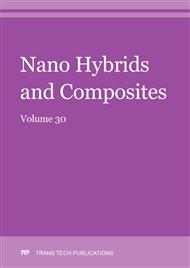[1]
Hussein, M.T., Kadhim A, Aadim, Eman K. Hassan, Structural and surface morphology Analysis of Copper Phthalocyanine thin film prepared by pulsed laser deposition and thermal evaporation techniques,, Advances in Materials Physics and Chemistry, Vol. p.6, 85-97, (2016).
DOI: 10.4236/ampc.2016.64009
Google Scholar
[2]
Hussein, M.T., Eman M. Nasir, F.A, Senaed Optical Properties of Cobalt-Phthalocyanine Thin Film,, INDIAN JOURNAL OF RESEARCH ,Vol. 9 ,pp.145-146,(2014).
Google Scholar
[3]
Sawanta S. Mali • Promod S. Patil • Popatrao N. Bhosale, Novel hybrid solar cells based on a-copper phthalocyanine– cadmium sulfide planar heterojunction,, J.Matere Sci., Vol.49, pp.5100-5111, (2014).
DOI: 10.1007/s10853-014-8218-z
Google Scholar
[4]
Selma M.H. Jawad, Zahra S. Ahmed, Wessal A.Taha, Optical Properties of Annealed Cadmium Sulfide Thin Film Prepared by Chemical Bath Deposition,,. Iraq Journal of Applied Physics Letters, Vol.2,( 2009).
Google Scholar
[5]
B. Zaidi, Introductory Chapter: Introduction to Photovoltaic Effect,, Solar Panels and Photovoltaic Materials, ISBN: 978-953-51-6173-8, IntechOpen (2018).
DOI: 10.5772/intechopen.74389
Google Scholar
[6]
B. Zaidi, B. Hadjoudja, B. Chouial, K. Kamli, A. Chibani, C. Shekhar, Impact of hydrogen passivation on electrical properties of polysilicon thin films, Silicon, Vol 10, (2018), pp.2161-2163.
DOI: 10.1007/s12633-017-9746-3
Google Scholar
[7]
M. Wojdyła, B. Derkowska, Z. Łukasiak, W. Bała,, Absorption and photo reflectance spectroscopy of zinc phthalocyanine (ZnPc) thin films grown by thermal evaporation,, Mater. Lett.,Vol. 60, p.3441–3446,(2006).
DOI: 10.1016/j.matlet.2006.03.029
Google Scholar
[8]
R. Sathyamoorthy, S. Senthilarasu, Structural orientations and optical band gap of zinc phthalocyanine (ZnPc) thin films,, J. Electrochem. Soc.Vol. 154, (2007).
DOI: 10.1149/1.2372580
Google Scholar
[9]
R.Hepzi Pramila Devamani, R.Kiruthika, P.Mahadevi and S.Sagithapriya,Synthesis and Characterization of Cadmium Sulfide Nanoparticles,, IJISET, Vol.4,pp.181-185,(2017).
Google Scholar
[10]
B.S. Kim, D.C.J. Neo, B. Hou, J.B. Park, Y. Cho, N. Zhang, J. Hong, S. Pak, S. Lee, J.I. Sohn, H.E. Assender, A.A.R. Watt, S. Cha, J.M. Kim, High performance PbS quantum dot/graphene hybrid solar cell with efficient charge extraction,, ACS Appl. Mater. Interfaces, Vol.8, (2016).
DOI: 10.1021/acsami.6b02544
Google Scholar
[11]
P.C. Preparation, N. Karousis, A. Sastre-santos, Zinc phthalocyanine – grapheme hybrid material for energy conversion: synthesis, characterization, photo-physics, and photo-electrochemical cell preparation,, J. Phys. Chem. C ,Vol.116, (2012).
DOI: 10.1021/jp305783v
Google Scholar
[12]
N.J. Ekins-Daukes, K.H. Lee, L. Hirst, A. Chan, M. Führer, J. Adams, B. Browne, K.W.J. Barnham, P. Stavrinou, J. Connolly, J.S. Roberts, B. Stevens, R. Airey, K. Kennedy, Controlling radiative loss in quantum well solar cells,, J. Phys. D Appl. Phys., Vol. 46, (2013).
DOI: 10.1088/0022-3727/46/26/264007
Google Scholar
[13]
M. Paxman, J. Nelson, B. Braun, J. Connolly, K.W.J. Barnham, C.T. Foxon, J.S. Roberts, Modeling the spectral response of the quantum well solar cell,, J. Appl.Phys.,Vol 74 (1993).
DOI: 10.1063/1.355275
Google Scholar


